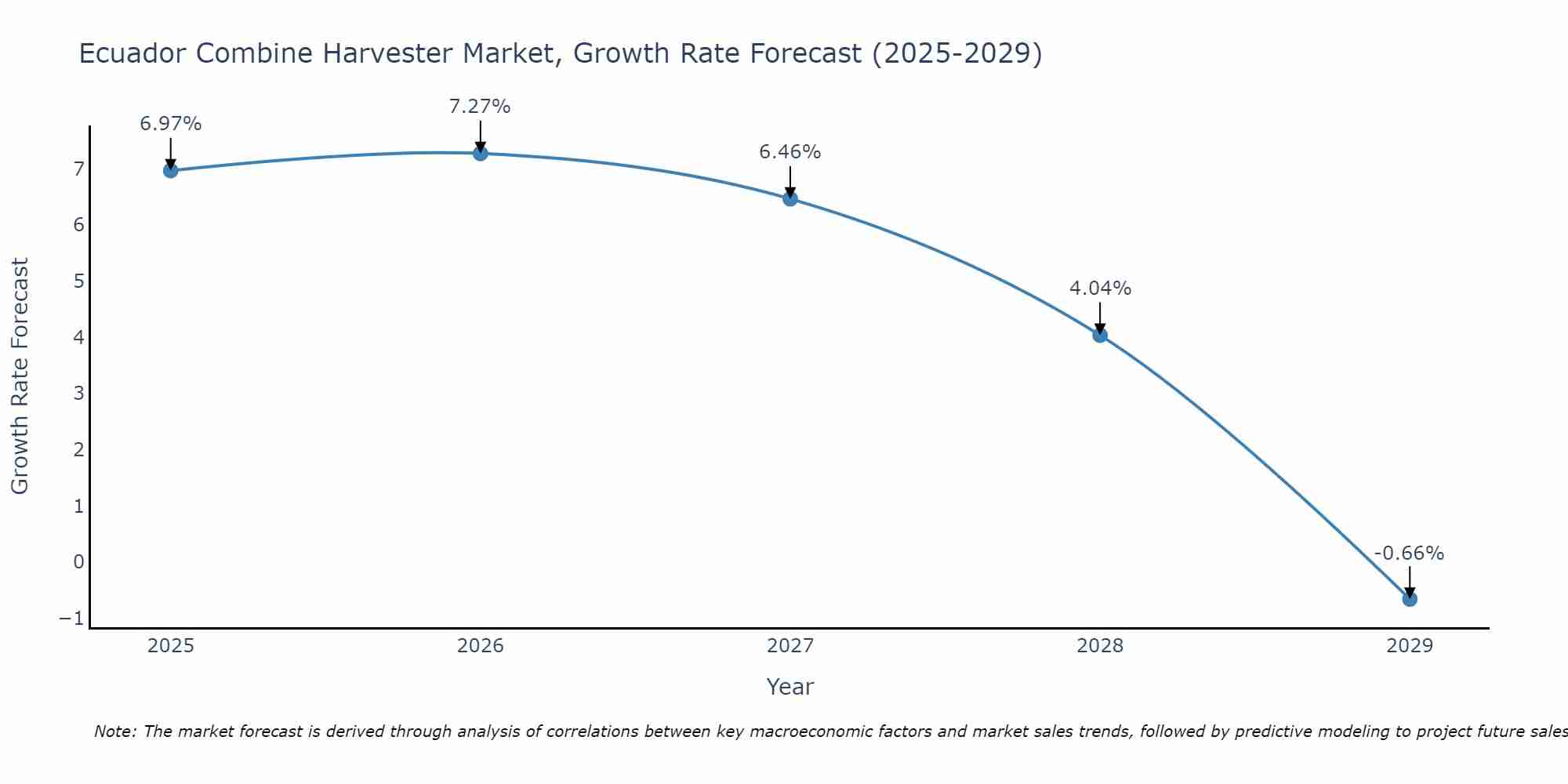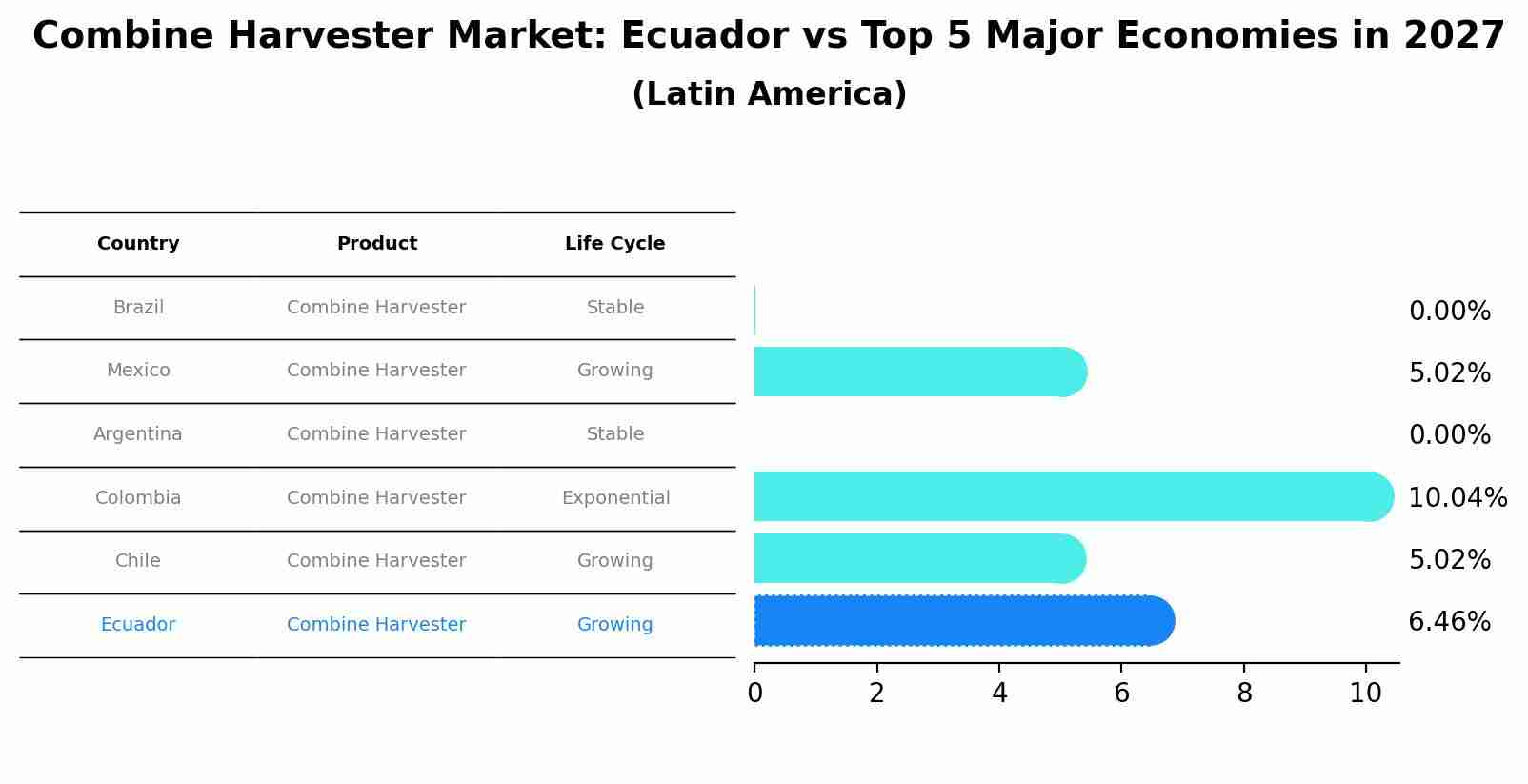Ecuador Combine Harvester Market (2025-2031) | Trends, Companies, Revenue, Forecast, Share, Outlook, Industry, Size, Analysis, Segmentation, Growth & Value
| Product Code: ETC5398232 | Publication Date: Nov 2023 | Updated Date: Aug 2025 | Product Type: Market Research Report | |
| Publisher: 6Wresearch | Author: Bhawna Singh | No. of Pages: 60 | No. of Figures: 30 | No. of Tables: 5 |
Ecuador Combine Harvester Market Size Growth Rate
The Ecuador Combine Harvester Market is projected to witness mixed growth rate patterns during 2025 to 2029. Starting at 6.97% in 2025, the market peaks at 7.27% in 2026, and settles at -0.66% by 2029.

Combine Harvester Market: Ecuador vs Top 5 Major Economies in 2027 (Latin America)
The Combine Harvester market in Ecuador is projected to grow at a growing growth rate of 6.46% by 2027, highlighting the country's increasing focus on advanced technologies within the Latin America region, where Brazil holds the dominant position, followed closely by Mexico, Argentina, Colombia and Chile, shaping overall regional demand.

Ecuador Combine Harvester Market Overview
The Ecuador Combine Harvester Market caters to the agricultural sector, providing machinery to improve crop harvesting efficiency. Increased mechanization in agriculture drives the demand for advanced combine harvesters, aiding in productivity and reducing labor costs.
Drivers of the market
The Ecuador Combine Harvester Market is influenced by the growing need for agricultural efficiency and productivity. As farmers seek to improve crop yields and reduce labor costs, the demand for advanced harvesting equipment is increasing. The adoption of precision agriculture techniques and mechanization trends in the agricultural sector further drive market growth.
Challenges of the market
The Combine Harvester Market faces challenges associated with fluctuating agricultural commodity prices. When prices are low, farmers may delay purchasing new equipment, impacting sales. Moreover, the market must address issues related to equipment maintenance and repair, which can affect operational efficiency and productivity in farming.
Government Policy of the market
Ecuadors policies support the agricultural sector by promoting mechanization through combine harvesters. The government provides subsidies and tax incentives for farmers investing in modern machinery, enhancing productivity. Regulations ensure equipment safety standards, aligning with Ecuadors goals for efficient and sustainable agriculture.
Key Highlights of the Report:
- Ecuador Combine Harvester Market Outlook
- Market Size of Ecuador Combine Harvester Market, 2024
- Forecast of Ecuador Combine Harvester Market, 2031
- Historical Data and Forecast of Ecuador Combine Harvester Revenues & Volume for the Period 2021-2031
- Ecuador Combine Harvester Market Trend Evolution
- Ecuador Combine Harvester Market Drivers and Challenges
- Ecuador Combine Harvester Price Trends
- Ecuador Combine Harvester Porter`s Five Forces
- Ecuador Combine Harvester Industry Life Cycle
- Historical Data and Forecast of Ecuador Combine Harvester Market Revenues & Volume By Cutting Width for the Period 2021-2031
- Historical Data and Forecast of Ecuador Combine Harvester Market Revenues & Volume By Small Size Combine Harvester for the Period 2021-2031
- Historical Data and Forecast of Ecuador Combine Harvester Market Revenues & Volume By Large Size Combine Harvester for the Period 2021-2031
- Historical Data and Forecast of Ecuador Combine Harvester Market Revenues & Volume By Type for the Period 2021-2031
- Historical Data and Forecast of Ecuador Combine Harvester Market Revenues & Volume By Wheel Type Combine Harvester for the Period 2021-2031
- Historical Data and Forecast of Ecuador Combine Harvester Market Revenues & Volume By Crawler Type Combine Harvester for the Period 2021-2031
- Historical Data and Forecast of Ecuador Combine Harvester Market Revenues & Volume By Power Source for the Period 2021-2031
- Historical Data and Forecast of Ecuador Combine Harvester Market Revenues & Volume By Tractor Pulled/PTO Powered Combine Harvester for the Period 2021-2031
- Historical Data and Forecast of Ecuador Combine Harvester Market Revenues & Volume By Self-Propelled Combine Harvester for the Period 2021-2031
- Ecuador Combine Harvester Import Export Trade Statistics
- Market Opportunity Assessment By Cutting Width
- Market Opportunity Assessment By Type
- Market Opportunity Assessment By Power Source
- Ecuador Combine Harvester Top Companies Market Share
- Ecuador Combine Harvester Competitive Benchmarking By Technical and Operational Parameters
- Ecuador Combine Harvester Company Profiles
- Ecuador Combine Harvester Key Strategic Recommendations
Frequently Asked Questions About the Market Study (FAQs):
1 Executive Summary |
2 Introduction |
2.1 Key Highlights of the Report |
2.2 Report Description |
2.3 Market Scope & Segmentation |
2.4 Research Methodology |
2.5 Assumptions |
3 Ecuador Combine Harvester Market Overview |
3.1 Ecuador Country Macro Economic Indicators |
3.2 Ecuador Combine Harvester Market Revenues & Volume, 2021 & 2031F |
3.3 Ecuador Combine Harvester Market - Industry Life Cycle |
3.4 Ecuador Combine Harvester Market - Porter's Five Forces |
3.5 Ecuador Combine Harvester Market Revenues & Volume Share, By Cutting Width, 2021 & 2031F |
3.6 Ecuador Combine Harvester Market Revenues & Volume Share, By Type, 2021 & 2031F |
3.7 Ecuador Combine Harvester Market Revenues & Volume Share, By Power Source, 2021 & 2031F |
4 Ecuador Combine Harvester Market Dynamics |
4.1 Impact Analysis |
4.2 Market Drivers |
4.2.1 Government subsidies and support for agricultural mechanization in Ecuador |
4.2.2 Increasing adoption of modern farming techniques and technologies |
4.2.3 Growing demand for higher efficiency and productivity in agriculture sector |
4.3 Market Restraints |
4.3.1 High initial investment and maintenance costs of combine harvesters |
4.3.2 Limited access to financing options for small-scale farmers in Ecuador |
5 Ecuador Combine Harvester Market Trends |
6 Ecuador Combine Harvester Market Segmentations |
6.1 Ecuador Combine Harvester Market, By Cutting Width |
6.1.1 Overview and Analysis |
6.1.2 Ecuador Combine Harvester Market Revenues & Volume, By Small Size Combine Harvester, 2021-2031F |
6.1.3 Ecuador Combine Harvester Market Revenues & Volume, By Large Size Combine Harvester, 2021-2031F |
6.2 Ecuador Combine Harvester Market, By Type |
6.2.1 Overview and Analysis |
6.2.2 Ecuador Combine Harvester Market Revenues & Volume, By Wheel Type Combine Harvester, 2021-2031F |
6.2.3 Ecuador Combine Harvester Market Revenues & Volume, By Crawler Type Combine Harvester, 2021-2031F |
6.3 Ecuador Combine Harvester Market, By Power Source |
6.3.1 Overview and Analysis |
6.3.2 Ecuador Combine Harvester Market Revenues & Volume, By Tractor Pulled/PTO Powered Combine Harvester, 2021-2031F |
6.3.3 Ecuador Combine Harvester Market Revenues & Volume, By Self-Propelled Combine Harvester, 2021-2031F |
7 Ecuador Combine Harvester Market Import-Export Trade Statistics |
7.1 Ecuador Combine Harvester Market Export to Major Countries |
7.2 Ecuador Combine Harvester Market Imports from Major Countries |
8 Ecuador Combine Harvester Market Key Performance Indicators |
8.1 Average age of combine harvesters in use in Ecuador |
8.2 Adoption rate of precision agriculture technologies in conjunction with combine harvesters |
8.3 Percentage of agricultural land in Ecuador using mechanized farming techniques |
9 Ecuador Combine Harvester Market - Opportunity Assessment |
9.1 Ecuador Combine Harvester Market Opportunity Assessment, By Cutting Width, 2021 & 2031F |
9.2 Ecuador Combine Harvester Market Opportunity Assessment, By Type, 2021 & 2031F |
9.3 Ecuador Combine Harvester Market Opportunity Assessment, By Power Source, 2021 & 2031F |
10 Ecuador Combine Harvester Market - Competitive Landscape |
10.1 Ecuador Combine Harvester Market Revenue Share, By Companies, 2024 |
10.2 Ecuador Combine Harvester Market Competitive Benchmarking, By Operating and Technical Parameters |
11 Company Profiles |
12 Recommendations | 13 Disclaimer |
- Single User License$ 1,995
- Department License$ 2,400
- Site License$ 3,120
- Global License$ 3,795
Search
Thought Leadership and Analyst Meet
Our Clients
Related Reports
- Germany Breakfast Food Market (2026-2032) | Industry, Share, Growth, Size, Companies, Value, Analysis, Revenue, Trends, Forecast & Outlook
- Australia Briquette Market (2025-2031) | Growth, Size, Revenue, Forecast, Analysis, Trends, Value, Share, Industry & Companies
- Vietnam System Integrator Market (2025-2031) | Size, Companies, Analysis, Industry, Value, Forecast, Growth, Trends, Revenue & Share
- ASEAN and Thailand Brain Health Supplements Market (2025-2031) | Strategy, Consumer Insights, Analysis, Investment Trends, Opportunities, Growth, Size, Share, Industry, Revenue, Segments, Value, Segmentation, Supply, Forecast, Restraints, Outlook, Competition, Drivers, Trends, Demand, Pricing Analysis, Competitive, Strategic Insights, Companies, Challenges
- ASEAN Bearings Market (2025-2031) | Strategy, Consumer Insights, Analysis, Investment Trends, Opportunities, Growth, Size, Share, Industry, Revenue, Segments, Value, Segmentation, Supply, Forecast, Restraints, Outlook, Competition, Drivers, Trends, Demand, Pricing Analysis, Competitive, Strategic Insights, Companies, Challenges
- Europe Flooring Market (2025-2031) | Outlook, Share, Industry, Trends, Forecast, Companies, Revenue, Size, Analysis, Growth & Value
- Saudi Arabia Manlift Market (2025-2031) | Outlook, Size, Growth, Trends, Companies, Industry, Revenue, Value, Share, Forecast & Analysis
- Uganda Excavator, Crane, and Wheel Loaders Market (2025-2031) | Strategy, Consumer Insights, Analysis, Investment Trends, Opportunities, Growth, Size, Share, Industry, Revenue, Segments, Value, Segmentation, Supply, Forecast, Restraints, Outlook, Competition, Drivers, Trends, Demand, Pricing Analysis, Competitive, Strategic Insights, Companies, Challenges
- Rwanda Excavator, Crane, and Wheel Loaders Market (2025-2031) | Strategy, Consumer Insights, Analysis, Investment Trends, Opportunities, Growth, Size, Share, Industry, Revenue, Segments, Value, Segmentation, Supply, Forecast, Restraints, Outlook, Competition, Drivers, Trends, Demand, Pricing Analysis, Competitive, Strategic Insights, Companies, Challenges
- Kenya Excavator, Crane, and Wheel Loaders Market (2025-2031) | Strategy, Consumer Insights, Analysis, Investment Trends, Opportunities, Growth, Size, Share, Industry, Revenue, Segments, Value, Segmentation, Supply, Forecast, Restraints, Outlook, Competition, Drivers, Trends, Demand, Pricing Analysis, Competitive, Strategic Insights, Companies, Challenges
Industry Events and Analyst Meet
Whitepaper
- Middle East & Africa Commercial Security Market Click here to view more.
- Middle East & Africa Fire Safety Systems & Equipment Market Click here to view more.
- GCC Drone Market Click here to view more.
- Middle East Lighting Fixture Market Click here to view more.
- GCC Physical & Perimeter Security Market Click here to view more.
6WResearch In News
- Doha a strategic location for EV manufacturing hub: IPA Qatar
- Demand for luxury TVs surging in the GCC, says Samsung
- Empowering Growth: The Thriving Journey of Bangladesh’s Cable Industry
- Demand for luxury TVs surging in the GCC, says Samsung
- Video call with a traditional healer? Once unthinkable, it’s now common in South Africa
- Intelligent Buildings To Smooth GCC’s Path To Net Zero


















